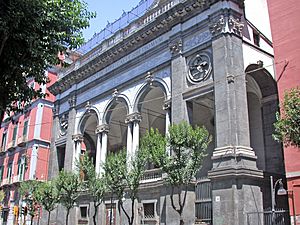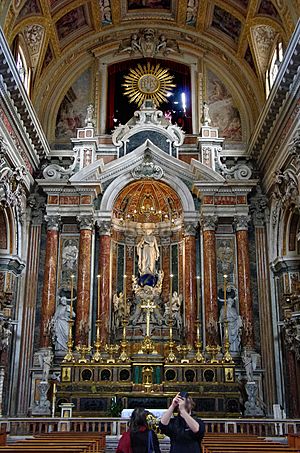Cosimo Fanzago facts for kids
Cosimo Fanzago (born October 12, 1591, in Clusone – died February 13, 1678, in Naples) was a famous Italian architect and sculptor. He is known as one of the best artists of the Baroque period in Naples, Italy.
Contents
Who Was Cosimo Fanzago?
Cosimo Fanzago was born in Clusone, a town in Italy. His family worked with bronze and also designed buildings. In 1608, he moved to Naples. There, he learned how to sculpt marble and work as a builder. His first important work was a tomb for Mario Carafa. He also designed his first church, San Giuseppe dei Vecchi a San Potito.
Fanzago became very popular in Naples. He got support from important groups like the Benedictines and the Carthusians. He soon opened his own workshop.
His Style and Later Life
Fanzago designed the church of Santa Maria Egiziaca a Pizzofalcone (built between 1651 and 1717). This church has a special Greek cross shape. It looks like a mix of famous Baroque buildings by artists like Bernini and Borromini.
He also designed the church of Santa Teresa a Chiaia. His last big church was Santa Maria Maggiore, built from 1653 to 1675. Cosimo Fanzago passed away when he was 87 years old. One of his students was Lorenzo Vaccaro.
Famous Works in Naples
Fanzago created many important buildings and artworks in Naples:
- Spire of San Gennaro: This tall monument honors the patron saint of Naples. It looks like the large decorations used in religious parades.
- Other Spires: He also helped design two other famous spires in Naples. These were built to thank God for protecting the city from a terrible sickness.
- Certosa di San Martino: Fanzago did a lot of work on this important monastery. He designed the amazing central courtyard with its big doorways and statues. The church and its cloisters (covered walkways) are thought to be his best work.
- Church Facades: He designed the fronts of many churches and buildings. These include Santa Maria degli Angeli, parts of the Cathedral of Naples, and the front of Santa Maria della Sapienza. He also designed the bronze gate for the royal treasury chapel.
- Chapels: He worked on the Cacace Chapel and the Chapel of Saint Anthony inside San Lorenzo Maggiore.
- Church Altars: Fanzago designed altars inside churches like Santa Maria la Nova and Santi Severino e Sossio.
- Public Fountains: He created beautiful public fountains, including the Fontana del Gigante and the Sebeto Fountain.
- Villa Donn'Anna: He also worked on this grand villa located in Posillipo.
Fanzago also created works outside of Naples, including at the Benedictine Abbey of Montecassino.
Images for kids
See also
 In Spanish: Cosimo Fanzago para niños
In Spanish: Cosimo Fanzago para niños









